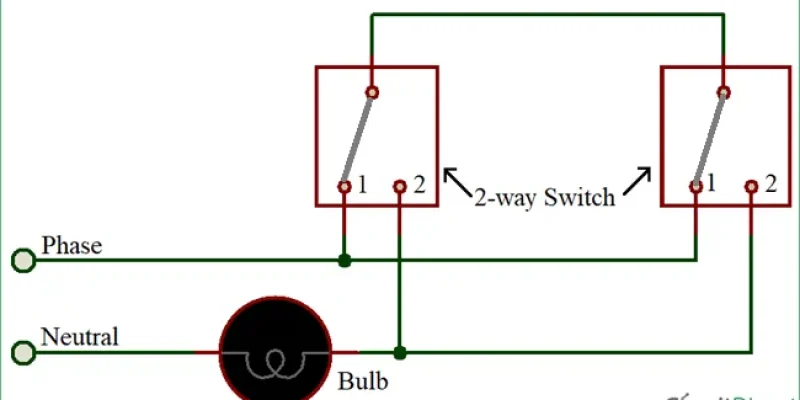Converting a traditional two-way switch to a smart switch can enhance home automation while preserving existing functionality, offering various solutions for different wiring setups and user preferences.
Understanding Two-Way Switching
Two-way switching allows control of a light or set of lights from multiple locations, commonly found in hallways or staircases. This setup typically involves two switches that can independently toggle the same lighting fixture. The challenge in converting to a smart system lies in maintaining this functionality while integrating modern technology, especially in homes without neutral wires at switch locations. Understanding the existing wiring configuration is crucial before attempting any smart switch installation, as it determines the most suitable approach for upgrading the system while preserving the convenience of multi-location control.
Заслуга в тому, що circuitdigest
Smart Switch Options
Several options are available for converting two-way switches to smart systems without disrupting existing functionality. For homes lacking neutral wires, specialized smart switches like Shelly 1L and Sonoff Mini can be installed in the light fixture’s junction box, allowing control via both existing switches and mobile apps. Alternatively, smart relays such as the Aeotec Nano Switch or Shelly 2.5 can be fitted behind standard switches, providing smart capabilities while maintaining traditional operation. For those preferring minimal wiring changes, wireless solutions like the Philips Hue Smart Button or Lutron Pico remote offer convenient control options.
Recommended Smart Devices
Several smart devices are highly recommended for converting two-way switches:
- Lutron Caseta Smart Switch: Considered one of the best overall smart switches, it works with major smart home systems and is easy to install.
- TP-Link Tapo Smart Switch and Wiz Smart Button: These offer excellent wired and wireless options for smart lighting control.
- Leviton Decora Smart Switch: Some models in this line do not require a neutral wire, making them suitable for older homes.
These devices offer a range of features, including compatibility with voice assistants, scheduling capabilities, and remote control via smartphone apps, enhancing the functionality of traditional two-way switch setups.
Етапи встановлення
When converting a two-way switch to a smart system, proper installation is crucial for safety and functionality. Here’s a step-by-step guide to installing a smart switch in a two-way circuit:
- Safety first: Turn off power at the circuit breaker and verify with a voltage tester that the circuit is dead before proceeding.
- Remove existing switches: Carefully remove the wall plates and unscrew the existing switches, taking note of the wire connections.
- Identify wires: In a typical two-way setup, you’ll find a common wire (usually black), two traveler wires (often red and white), and possibly a ground wire (bare copper or green). Some smart switches require a neutral wire, which may not be present in older installations.
- Choose the right location: For optimal performance, install the smart switch between the load (light fixture) and the last traditional switch. This configuration allows for proper communication and control.
- Connect the smart switch:
- Connect the line (power source) and neutral (if available) directly to the smart switch.
- Connect the load wire to the smart switch’s load terminal.
- Connect traveler wires as per the manufacturer’s instructions.
- Ensure the ground wire is properly connected.
- Install the companion switch: If your smart switch kit includes a companion switch for the second location, install it according to the provided instructions.
- Secure and test: Carefully tuck the wires back into the box, secure the switches, and replace the wall plates. Turn the power back on and test the functionality of both the smart switch and the traditional switch.
- Configure the smart switch: Follow the manufacturer’s instructions to connect the switch to your home’s Wi-Fi network and set up any associated apps or smart home integrations.
For homes without neutral wires, consider smart switches specifically designed for no-neutral installations or explore alternative solutions like smart relays installed at the fixture.
Remember that while many DIY enthusiasts can handle this installation, if you’re unsure about any step or encounter unexpected wiring configurations, it’s best to consult a licensed electrician to ensure safety and proper functionality.



